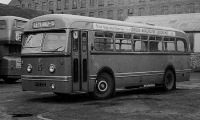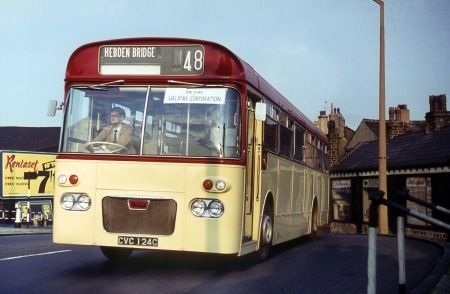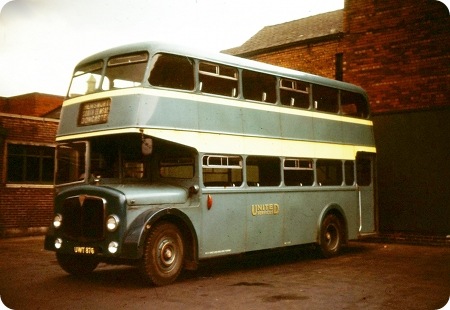
J Fishwick & Sons
1951
Leyland Olympic
Metro Cammell Weymann B44F
I took this photo as I have previously said on a trip to the Fishwick depot at Leyland in Lancashire considering there location it is hardly surprising what vehicles they favoured. There livery was and probable still is a Moss Green and Dark Green which was different but quite nice. Practically all there service routes are local and either start, finish or go through Leyland I think the longer distance routes in the area will be handled by Stagecoach Ribble.
I have read somewhere that the Leyland Olympic and the Royal Tiger more or less began the end of the vertical front engine single decker bus, as the AEC Reliance came along three years later then the article could have a point. The Olympic was built in conjunction with the body builder Metro Cammell Weymann and I think most of them went overseas rather than the home market.
I actually e-mailed J Fishwick & Sons for any information of the above bus, as the company is one of a very few original operators still in existence, and they would have information going back to year dot. They did not even acknowledge receipt of my mail never mind supply information, shame really. The days must have gone when you could write and ask an operator for a fleet list and by return of post it arrived along with a sample set of bus tickets an the odd photo of there latest arrival. The credit crunch must be squeezing quite tight up in Leyland.
Hi, came across this picture searching around for Fishwick bus photo’s, I am from the Leyland area and although I can’t shed any light on this bus, I do have a picture of an almost identical Fishwicks bus taken last week at a bus rally in Leyland. As for the company, I am quite surprised you received no response from your email, Fishwicks seem to be quite keen on the history and tradition and always send a number of buses to local rallies and have a downloadable fleet list on their website. Anyway thanks for the picture.
Graham Rutherford
When I was a lad of 16 years, I was an apprentice to the Jamaica Omnibus Company in Kingston Jamaica. This was in 1968 and the outgoing busses on the fleet at the time were the Leyland Olympic A, B, and C the "C" being the long chassis version. They were replaced with the "G" Busses. These were clutchless with pneumatic shift levers. This photo certainly brings back memories.
Albert Walker
I have tried to email J Fishwick & Sons with regard to the single decker Leyland Olympian twice. I have been ignored by the company on both occasions. Apart from being amazingly ignorant or perhaps not very good at email can anybody tell me anything about them and especially the single decker Leyland Olympian 521 CTF. Do they still have the bus, is it still running? What do you know?
Edward Cambridge
Edward, this is a video of the actual Leyland Olympian 521 CTF.
Terry Malloy
You may be able to get more info from:-
Leyland Commercial Vehicle Museum.
King Street
Leyland
Nr Preston
Lancashire
PR25 2LE
Keith
I went to school on Fishwick’s buses 1959-1961, usually coming home on the 4.30PM Preston Fox Street to "Seven Stars via Croston Rosd" (actually service 115 but Fishwicks had no number displays in them days. It was regularly no.13, NTC 232 on the 4.30, usually full especially on market days, with a standing load, and people left behind. Passengers for Croston Road were rightly annoyed when Penwortham passengers were on, as they had the frequent "Earnshaw Bridge" bus (111). All other Croston Road buses were double deckers, but never this one.
Fishwicks had 8 Olympics, and 6 Olympians at this time, mostly for the Chorley routes under Pack Saddle Bridge, and the Bamber Bridge route along Shady Lane.
I could go on….
Bernard Parkinson
Apologies for digressing slightly but where did Bamber Bridge Motor Services fit into this picture? Was their route from Preston to Bamber Bridge exactly same as Fishwicks and if so was there a co-ordinated timetable? Did BBMS operate one route only?
Chris Barker
Fishwick’s Bamber Bridge route was today’s service 117, but ran every 90 minutes then, all day incl evenings and Sundays, but went via Shady Lane before Clayton Brook village was expanded by Central Lancs New Town. As today it ran via Brownedge Road, so did not compete with BBMS. This service always displayed simply "Bamber Bridge" whichever way it was going, despite its destination being Preston or Leyland (Earnshaw Bridge).
BBMS just ran one service direct Preston (Starch House Square)-Bamber Bridge (Hob Inn), plus works services to Leyland and Lostock Hall, In its latter years one service deviated via Duddle Lane (service D), while the direct route became service P (via Pear Tree).
Bernard Parkinson
Olympian 521 CTF is preserved and appears at rallies, not sure who owns it.
Spent most of its life working 109 and 119 routes, but also worked regularly the Sunday morning Croston Road service, (115), 10.12 and 11.12 from Moss Side (Black Bull) to Preston (Fox Street), 10.43 and 11.43 return (Seven Stars via Croston Road), which service actually went beyond Seven Stars up Slater Lane terminating at the Black Bull, then back along Dunkirk Lane to Preston. There was no 12.12 service on a Sunday, but the 1.12PM service resumed with the regular Croston Road bus no.23, LTD 445, a PD2/1, and worked this run every hour until 11.0pm.
The last Olympic to survive was no 17, NTC 234, which was 21 years old when withdrawn, its regular job in its last days was the Vernons Mill to Earnshaw Bridge service, which needed a single decker to get through Factory Lane tunnel under the railway. In earlier days two Olympics together worked this job, such was demand, one just to Lostock Hall,the other working through to Earnshaw Bridge, as shown in the 111 timetable of the day.
Bernard Parkinson
29/01/12 – 11:14
521 CTF Leyland Olympian Single Decker was sold by Fishwick to a man called M.Hayes, Mark Hayes I believe.
He apparently has a private bus collection and does exhibit the bus. Does anybody know anything about him?
E. Cambridge
29/01/12 – 16:30
Yorkshire Woollen had a number of these buses. My wife was a clippie at Frost Hill at Liversedge and remembers these buses being on service 36 between Leeds and Elland. On one occasion a driver drove through very deep flood water quite fast and the water came up through the inspection floor boards.
Philip Carlton
06/03/12 – 12:10
I Found the 521 CTF Bus. It is in the British Commercial Vehicle Museum. I shall visit it this Spring. Thank You All.
Edward Cambridge
25/10/15 – 06:23
It has been reported in the local media that the company went into administration Tuesday and the last service on the 111 route will be today.
A sad ending to a company that had high standards and delighted many of us over the years with the one off and unusual Buses that they operated.
The end of an era and a sad day for the Town of Leyland.
Cyril Aston
26/10/15 – 06:49
Very sad news about Fishwick & Sons. Another old-established and well-respected operator ceases to trade. Is there any indication about what happens to their services, most of which were run in conjunction with Ribble?
Pete Davies
26/10/15 – 06:50
Philip – how interesting to read that your good lady was on the 36 route – in the early 1950s I used to travel on the nearly new Olympics from Leeds to the top of Wide Lane at Morley to visit a friend. That they were of "semi integral" or "chassisless" construction was obvious from the moment the driver pressed the starter as everything from floors to luggage racks and windows began to rattle and thud and the journeys were very uncomfortable – a great shame because they were handsome and lively vehicles, but there we are.
Cyril – what an awful piece of news you’ve had to break to us. Being a traditionalist myself, but fully accepting changes in the Industry, I have always held Fishwick’s in the very highest esteem. Their colours, criticised by many as "dour", "drab" etc, are a tribute to unashamed dignity and smartness and the demise of the Company is a very sad loss indeed. Presumably and hopefully any staff so wishing will be accommodated by other operators in the area, while those sadly wanting to call it a day will be able to do so voluntarily.
Chris Youhill
26/10/15 – 16:14
I understand from the "Lancashire Evening Post" that Stagecoach are taking over the 111 service, but that the others will be subject to the tendering process.
Pete Davies
27/10/15 – 06:38
Just picking up on a couple of points above.
Bernard P – it may have been that Fishwick’s were not authorised to carry through passengers on the 117 service. Such restrictions were rife in the decades following Road Service Licensing (1930) and only began to be seriously eliminated with the so-called County Council ‘agency agreements’ of the late 1970s. Or Fishwicks may have found that it caused less confusion to passengers to do things the way they did.
Are you sure there didn’t come a point on the route where the destination was changed to ‘Earnshaw Bridge’ or ‘Preston’?
Pete D – I think you’ll find that in recent decades the only route which was operated by both Fishwicks and Ribble (to a co-ordinated timetable) was the 109. The fact that most of the other routes were numbered in the Ribble series was a leftover from pre-deregulation days when services were technically ‘joint’ with Ribble (i.e. operated under a joint licence) even though Ribble may have never actually operated on particular routes.
This is how Pennine’s Skipton to Malham service was service 211, in pre-deregulation days the services was ‘joint’ with Ribble, even though I don’t think Ribble ever provided any vehicles. Funny thing is, I don’t think Pennine vehicles carried route numbers until well after deregulation anyway!
There were lots and lots of services where Ribble had a stake, but didn’t provide any vehicles, e.g. the 39 from ‘Manchester’ (actually Salford) to Liverpool, which was mainly (perhaps entirely) operated by LUT.
The converse applied too, the 130 (Bolton-Morecambe) was joint Ribble/Bolton Corporation, but Bolton didn’t operate, instead they did the 122 (Bolton-Southport).
David Call
28/10/15 – 13:25
Further to the above, further reflection seems to say that the Malham service was 210, rather than 211.
David Call
29/10/15 – 16:40
A real shame to hear that Fishwick has gone under. There will be no question of Stagecoach maintaining the brand name, unlike the situation in Nottingham where the South Notts and Pathfinder brands continue in use as a positive marketing feature.
Alan Murray-Rust
22/10/18 – 06:12
Birmingham City Transport also ran 5 Leyland Olympics. 4 where based at Selly Oak Depot, and one JOJ 261 was used on the Hall of Memory/Birmingham Airport service. This one was based near the city centre.
They were Leylands first under floor engined chassisless single deckers. I believe only 23 were built.
I remember being amazed at seeing a engine on its side apparently suspended in mid air as the lack of a conventional chassis gave the impression the engine/gearbox were not attached to anything,
They where very high floored not easy to board for the elderly or disabled.
They where known to as Geeps by the staff at Selly Oak. I loved them, they were very lively and my first speeding caution was in one of them.
John Hipkins
 Vehicle reminder shot for this posting
Vehicle reminder shot for this posting
09/04/21 – 07:25
The bus in question is a integrated body with a Leyland engine fitted to a Albion box it is in a private collection cause my mates owns it.
Aidy Burrows





